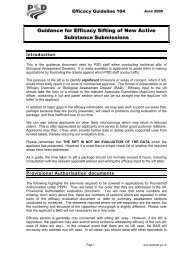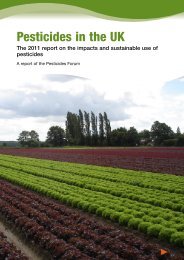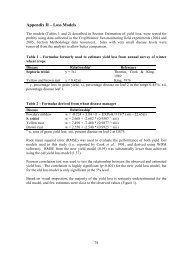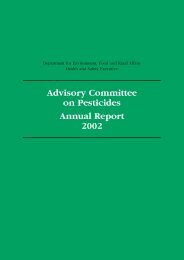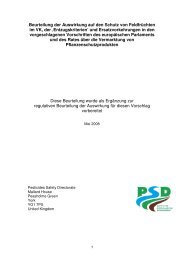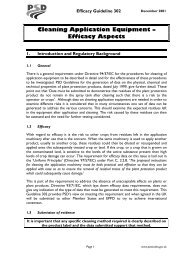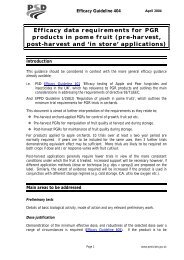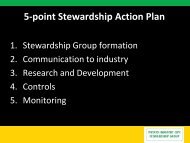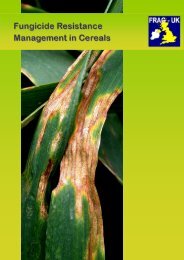Advisory Committee on Pesticides Annual Report 2001
ACP Annual Report 2001 - Pesticides Safety Directorate
ACP Annual Report 2001 - Pesticides Safety Directorate
Create successful ePaper yourself
Turn your PDF publications into a flip-book with our unique Google optimized e-Paper software.
Secti<strong>on</strong> E: UK Review Programme<br />
protecti<strong>on</strong> requirements and the provisi<strong>on</strong> of further data. It also identified<br />
a need for c<strong>on</strong>tinuing m<strong>on</strong>itoring of residues in food, particularly bran.<br />
This need would be referred to the <strong>Pesticides</strong> Residues <str<strong>on</strong>g>Committee</str<strong>on</strong>g>.<br />
Tolclofos-methyl<br />
Tolclofos-methyl is an organophosphorus fungicide formulated in a range of<br />
products approved for use <strong>on</strong> potato and various horticultural crops. There are<br />
no products approved for amateur use. In January <strong>2001</strong>, the ACP c<strong>on</strong>sidered<br />
a human health review of this active substance as part of a comprehensive<br />
review of anticholinesterase compounds.<br />
The <str<strong>on</strong>g>Committee</str<strong>on</strong>g> agreed that an ADI value should be set at 0.07 mg/kg bw/day<br />
based <strong>on</strong> the NOAEL of 6.5 mg/kg bw/day for reduced brain cholinesterase<br />
activity and increased absolute and relative kidney weights in a two-year<br />
mouse carcinogenicity study, and applying a 100-fold assessment factor.<br />
The <str<strong>on</strong>g>Committee</str<strong>on</strong>g> agreed that there were no acute or developmental effects <strong>on</strong><br />
which it was appropriate to set an ARfD.<br />
In view of the usage patterns of tolclofos methyl, the <str<strong>on</strong>g>Committee</str<strong>on</strong>g> agreed that<br />
both short-term and l<strong>on</strong>g-term systemic AOELs were appropriate to the<br />
operator risk assessment. A short-term systemic AOEL of 0.13 mg/kg bw/day<br />
was agreed for the operator risk assessment relating to seas<strong>on</strong>al uses (i.e. < 90<br />
days’ operator exposure per year), based <strong>on</strong> the NOAEL for increased liver<br />
weights, reduced bodyweight gain and increased alkaline phosphatase activity<br />
in a six-m<strong>on</strong>th dog study. A l<strong>on</strong>g-term systemic AOEL of 0.042 mg/kg bw/day<br />
was agreed for the operator risk assessment relating to more frequent usage<br />
(i.e. > 90 days’ operator exposure per year), based <strong>on</strong> the same end point as<br />
the ADI. For both of these reference values, a correcti<strong>on</strong> factor of 60 percent<br />
was applied to take account of incomplete oral absorpti<strong>on</strong>, and a 100-fold<br />
assessment factor was used.<br />
51<br />
The <str<strong>on</strong>g>Committee</str<strong>on</strong>g> c<strong>on</strong>sidered that the estimates of exposure to operators,<br />
workers and bystanders were acceptable, subject to additi<strong>on</strong>al operator<br />
protecti<strong>on</strong> requirements, and the provisi<strong>on</strong> of c<strong>on</strong>firmatory data.<br />
On the basis of the residue data provided, the <str<strong>on</strong>g>Committee</str<strong>on</strong>g> c<strong>on</strong>sidered that<br />
estimates of c<strong>on</strong>sumer exposure were acceptable, although c<strong>on</strong>firmatory data<br />
were required.<br />
The <str<strong>on</strong>g>Committee</str<strong>on</strong>g> agreed to advise Ministers that approvals should be allowed<br />
to c<strong>on</strong>tinue subject to the impositi<strong>on</strong> of additi<strong>on</strong>al operator protecti<strong>on</strong>




